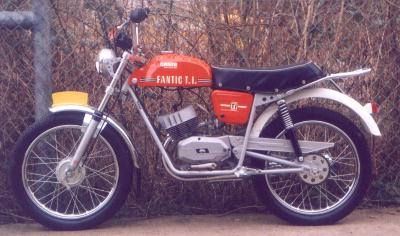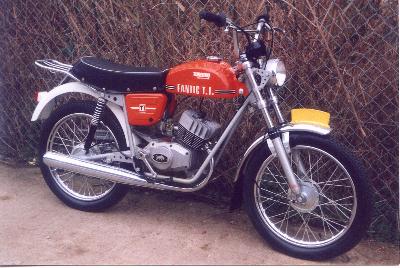 Go to the Archive
index
Go to the Archive
indexOur story starts in the twilight of 1971 with a change in licensing legislation that was to achieve infamy, becoming more widely known as the sixteener law. Hereon for their first motoring year, instead of being able to step straight onto a 250 with Ls, teens found themselves limited to 50cc mopeds. Little could the bureaucrats of the time have suspected the unique race of machines their safe intentions were about to create.
Driven by a natural instinct to want the best and the fastest, a whole new market became created overnight, and the great commercial machine was swung into action to meet the new teenage demand. At this time, the law defined a moped as "A machine not exceeding 50cc and equipped with pedals by means of which it is capable of being propelled" - but it never said anything about how fast it could go! And so the stage was set for the coming of: The Sports Moped!
The new generation machines quickly began to emulate the appearance and performance of their aspired to motor cycle cousins, as image and greater speed became seen as the key to increased sales. Fifty-cc specification and power output increased at a meteoric rate while the pedal facility shrivelled to a barely operable token just to satisfy the law.
Some of the finest mopeds of all time were born of this brief age, with true classics like the Yamaha FS1E, Puch Monza and Kriedler Florett, but the ultimate exotica were surely produced by the Italians. Capabilities of the 4-speed Garelli Record and 5-speed Malaguti Olympique were amazing, and also up there among the very best, the specification of the Fantic TI was just absolutely staggering - this was a moped with six gears! It could also develop enough power to make use of them most of the time, with 6.5bhp @ 7,000rpm from 12:1 compression ratio and breathing through a 14mm Dell'Orto. As if this wasn't enough, the fashion of the day for the TI model was to replace the stock inlet manifold, carb and air filter with a massive 19mm Dell#orto kit to boost the power to a full blown 7.2bhp! While this actually contributed very little to the top speed, it did make a noticeable improvement to the acceleration, and boy, didn't it sound good! In this form, induction roar was practically unsuppressed by the big gauze filter and the sound of a TI on throttle was characterised by a haunting Banshee howl as the revs soared to the motor's astronomical capability.

The light action clutch was probably an essential with the continuous gear changes required to keep the Minarelli power plant on the boil, which, at the level of tune, was pretty much the only way to ride it. The big finned, angular motor was a bold statement of pure styling while the 'alternative prancing horse' badge on the side of the clutch case cheekily echoed the sporting image of Ferrari. This incredible package was installed in a silver duplex frame and trimmed as a miniature street-trail, with cycle parts typically finished in vivid colours, yellow, green, or orange as the feature bike. TI models were available with 4 or 6-speed boxes, sharing the same 1st, 2nd and top gears, the '6' effectively becoming a high range close ratio set for all out tuck shop racers.
Here we are then, all set up with street cred factor ten and ready to go. So, with pedals, how do you actually work a six-speed foot-change on the left and a foot-brake on the right? Well, for the benefit of the greater readership who are probably more familiar with traditional arrangements, one pedal springs out to rotate by 180 degrees, and locks back in for the pair to hang down as footrests. As functional pedals, the facility is practically impossible, since you have to select top gear, hold in the clutch, and flail away like a mad thing to try and maintain enough forward momentum just to remain upright! Such futile efforts are however classified in the 'dangerous sports' category since the close proximity of the gear and brake levers are capable of inflicting crippling injuries during such activities; but get real! Who's ever going to need to pedal a machine with motor like this?

Starting is normally performed by rotating back either pedal into an up position and pushing down in the normal way, as the motor starts the pedals simply reassumed the dangling position to act as footrests. On the carb, the choke lever is pushed down to click-on, and snaps off when the throttle is opened full.
Acceleration comprises a rapid series of loud bursts up to howling revs and a whole world of gear-changes. You never really know where you are in the box, you just keep clicking either way until the gears run out at the top or the bottom! Illumination was notoriously bad and it became standard practice to wire in a switch to knock off the back light and get more power to the front, or you just couldn't see where you were going on dark country lanes.
Yes, I know you'll all be asking: so how fast does it go? Well to be honest, despite the specification, it wasn't the all-out quickest of its time. Going from the 80mph Veglia speedo, under normal conditions 55 was pretty typical with flash readings up to 65 under ideal strong tailwind conditions and laying on the tank.
The problem was that the TI had its Achilles Heel, it seemed to have an in-built suicide chip which gave it a tendency to blow-up if you held it flat out for much more than half a mile! It'd go happily all day at 45, but the full potential could only safely be used in short bursts. They'd all do it sometime, guaranteed; there'd be a tinkling noise as the Dykes top ring broke up, went out through the port in bits, and rattled around in the exhaust pipe. The motor rarely seized, but speed would instantly fall back to the 40s. Often it was just a case of whipping off the top end and slipping in another ring from the stock you soon got the habit of holding for these common events. Occasionally the piston suffered as well, and periodically a rebore would be required to remove the accumulated history of disasters. The cause of the trouble was the cast iron barrel that just didn't transmit the heat away from the cylinder quick enough when you started caning it. Aluminium barrels were the answer as fitted to the Caballero and GT (though these were only 4-gear models), replacing the cast iron TI component with this kit would completely solve the problems and you could end up with an unburstable, 6-speed gem! Few teens knew this solution and the TI was slain for its frailties. Compared to the more traditional definition of a moped, the TI is specified like a starship, but the light that burns twice as brightly only burns half as long and, mercilessly thrashed at the hands of a 16 year old, the Fantic was just another mayfly. That's probably why you don't see them anymore, they've all been hammered to oblivion. Increasing social concern over the frequency of Sports Moped "incidents" rapidly led to another re-definition of the moped. On 1st of August 1977 the 50 had it's 'teeth pulled' as it became restricted to a design maximum of 30mph, and the pedals became recognised as a legal irrelevance. The Great Golden Age fizzled out as the last unrestricted manufacturers stocks drained from the shops, and the country drifted into an interminable lifeless period that still persists today - The Grey Age, the Era of the Slo-ped, the Time of the Euro! God help us!
Given one of these machines in today's age of 30mph restricted scooters, a teenager could - Rule the World!
First published, August 2001